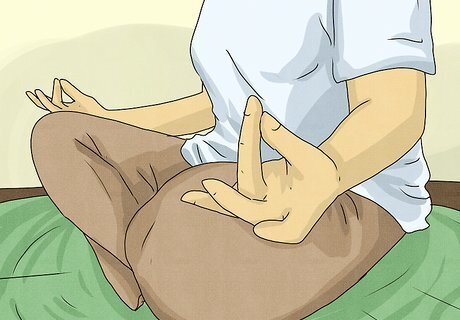
views
- Your mantra can reflect whatever intention you have for your practice. Use Christian, Sanskrit, or modern mantras that reflect your goals.
- Repeat your mantra in a low voice for the duration of your practice. While you do, focus deeply on the words you're saying and their meaning.
- Mantras have tons of spiritual and health benefits. Many people report feeling more at peace and less stressed.
Choosing your Mantra

Practice using powerful Sanskrit mantras. It's thought that these mantras were created by ancient sages, and they were meant to be hand selected by the universe for spiritual practices. So if you're looking for a tride-and-true method that's been tested for centuries, go with a Sanskrit mantra. "Om." Chanting "Om" is thought to be the universal sound, alive in everything. "Om Namah Shivaya". This represents the five elements: earth, water, fire, air, and space. This chant can feel purifying and empowering. "Lokah Samastah Sukinoh Bhavantu". This translates to: “May all beings everywhere be happy and free, and may the thoughts, words, and actions of my own life contribute in some way to that happiness and to that freedom for all.”

Select a Christian mantra to enhance your chanting. If you practice Christianity, you might feel more drawn to a mantra that praises Him. Choose a mantra that makes you feel empowered by His divine love or makes you feel closer to Him in your day to day life. Try these chants to get started: “The joy of the Lord is my strength” (Nehemiah 8:10). Use this mantra when you're facing a challenge to feel His power working in you. “All things work together for good” (Romans 8:28). When you're feeling stressed or hopeless, remind yourself that He has a plan for you. “The Lord is near to all who call on Him” (Psalm 145:18). Try this mantra if you find yourself feeling lonely or out of touch with God.

Find peace using an empowering, modern mantra. Some people don't use religion as the foundation for their mantra chants. Though the practice has divine, spiritual roots, it can feel personally meaningful and effective without a religious message. Choose a mantra that makes you feel powerful, or if you want, create your own mantra instead. "I have a purpose, my life has purpose." Struggling to feel connected to your life's goals and meanings? Try out this emboldening chant. "I am enough, I am worthy." Confidence can be complicated for anyone. Help to see all the great things you are through this gorgeous mantra. "This is exactly where I'm meant to be." Regret and uncertainty can take a major toll day to day. Use this chant to change your mind's narrative.
Chanting

Envision your divine inspiration. If your chants have a religious foundation, take a moment connect with it before moving forward. Conjure an image of the God you worship, pray to God, or just think about all of the things that you're grateful for in your life. This is a highly spiritual and intuitive practice, so go with whatever makes the most sense to you.

Pronounce the chant in a low volume and enunciate the vowels. Speak quietly, like you’re talking to someone right in front of you. Most people hold vowels for 1-3 seconds longer than normal, so if you're unsure, try using that as a starting point. If you aren’t sure how to hold a chant, try a few different variations until you find something that feels right to you. Try out these tips, too: Use any melody you’d like. Once you settle into a rhythm with a melody, focus on repeating the same pattern over and over. For example, if you’re chanting "om", you may hold the "o" sound and slowly taper down into the "m." Or, you could just as easily use a short "o" sound, then follow with a long "m" sound. Many people prefer chanting silently because it’s easier to focus on the meaning of the words.

Keep a meditation mala or rosary to count each chant off. A meditation mala is a bracelet or necklace with 108 beads on it. Many Eastern religions use meditation malas to count through the chants by moving their fingers from one bead to another after each chant. This helps to focus on the meaning of the words and get into a groove. By moving your fingers from bead to bead, your hands will start following the pattern of your speech, which can help center and focus you. You can always set a timer to 15-30 minutes and chant as well. Though for some, the alarm at the end of a peaceful chanting period is pretty disruptive. Or, try something simpler. Chanting silently for 3-5 minutes before a big meeting, test, or interview is a great way to enter a positive headspace.

Focus on the pattern and meaning of the words as you repeat them. Many people that chant feel themselves entering a kind of trance where the meaning of the chant and the sounds that accompany them cause them to enter a unique, spiritual headspace. But if you're having trouble doing this naturally, focus on your chant's meaning (after all, you chose it for a reason!). If you struggle to stick to those thoughts, try meditating on these questions instead: What do I want? Am I looking for focus, peace, or spiritual connection? What am I grateful for? My life is filled with so many blessings already. What do the people around me need? We're all connected, and by meditating on the desires of others, you'll feel more altruistic and at peace.

Meditate for a few minutes when you finish chanting. After repeating your mantra, sit quietly and focus on your breath. Let thoughts come and go, gently bringing your mind back to your breathing each time. Know that your thoughts are just distractions and are meaningless in themselves, so don’t allow yourself to react emotionally to them. This is your time to be calm and still after practicing your mantra.
Developing the Mindset

Reflect on the practice's benefits to inspire you. Before you try out chanting mantras, take a second to appreciate all of the mental and emotional changes you'll be opening yourself up to. Relaxation, focus, positive mood, and even feelings of altruism might be effects of chanting mantras. The benefits are still a little mysterious, but chanting mantras has also been thought to improve PTSD symptoms and emotional exhaustion.

Create a quiet, comfortable space to enjoy your practice. For example, nature is inspiring—maybe listening to birds or water flow will help you concentrate. Or, if you're indoors, block out other sounds by shutting the door and turning on a fan. Finally, turn off your electronic devices (like your TV and cellphone), to remove any potential distractions. Think about things that help you feel more focused and relaxed. Maybe you'll want to add a candle or a rain sound machine.

Find a comfortable position that you can hold for the entire practice. Sit or stand in whatever position feels most relaxing to you (becuase uncomfortable positions will be distracting). For example, stand like Chinese practitioners do during Tai-Chi or Chi Gung exercises. Or, try a sitting position, like Yogis. If you are flexible and used to the position, sit in the lotus position. Whatever position you take on, keep your back straight, but not rigid. Do your best to avoid slouching. Many people choose a cross-legged meditation position. Make this positions easier by putting your back against a wall and using a towel under your ankles. Or, sit upright in a chair. Press your thighs against the chair and make sure your feet have good contact with the ground. Keep your spine straight and your chest raised.

Relax before you begin chanting. If you can, clear your mind. Concentrate on different parts of your body and notice any tension there. Pretend like you're floating underwater and let your muscles go loose. Or, imagine that you're in a happy place, like the beach. Relaxing prior to mantra chanting can help you go into the practice with the best possible mindset.

Take deep breaths. During meditation, breathing is extremely important. This is how you'll take control over your chanting and how you'll maintain a good rhythm. Inhale slowly through your nose. Count to 10 in your head and hold your breath for 10 more seconds. Then exhale for 10 seconds. Continue doing this for 3 minutes, at the least. EXPERT TIP Soken Graf Soken Graf Certified Meditation Coach Soken Graf is a Meditation Coach, Buddhist Priest, Certified Advanced Rolfer, and a Published Author who runs Bodhi Heart Rolfing and Meditation, a spiritual life coaching business based in New York City, New York. Soken has over 25 years of Buddhist training experience and advises entrepreneurs, business owners, designers, and professionals. He has worked with organizations such as the American Management Association as a consultant for training courses on such topics as Mindful Leadership, Cultivating Awareness, and Understanding Wisdom: The Compassionate Principles of Work-Life Balance. In addition to his work as a priest, Soken has certifications in Advanced Rolfing from the Rolf Institute of Structural Integration, Visceral Manipulation, Craniosacral Therapy, SourcePoint Therapy®, and Cold-Laser Therapy. Soken Graf Soken Graf Certified Meditation Coach Our Expert Agrees: When you're meditating, stay aware of your breath cycle—typically, you'll breathe in, then pause, breathe out, then pause. For instance, you might count as you breathe in and out, then eventually you'll let go of the counting altogether and you're just aware of your body breathing almost involuntarily. During deep breathing, your abdomen should rise as you inhale and slowly drop as you exhale.

Consider joining a class or group if you're having trouble focusing. Sometimes, sitting alone in a quiet room, you might find it difficult to really focus and prep for your mantra session. But an instructor can guide you with proper breathing and help you find the right state of mind. Join a group or class, and others' focus might help you find your focus, too.




















Comments
0 comment